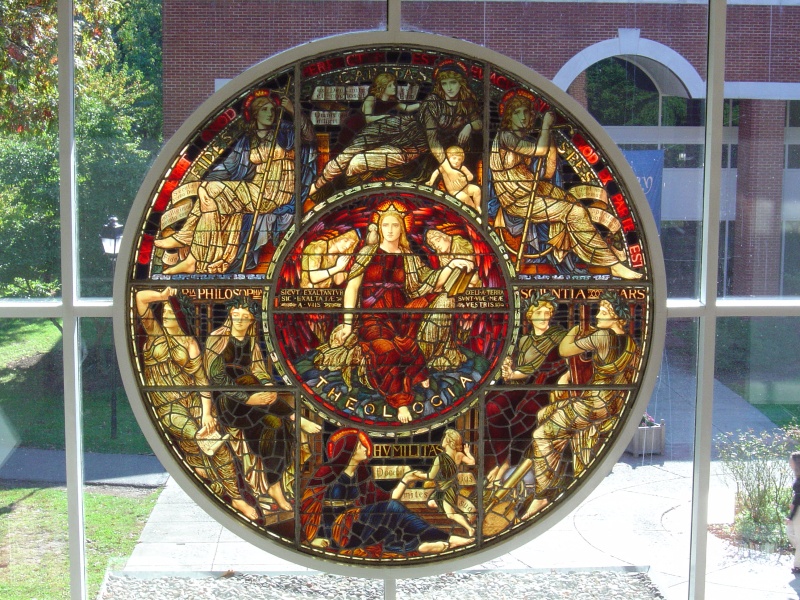Тhe Rose Window-Drew University-1883
Този прозорец на Розата,стои още в Университета Дрю,изобразявайки стремежа към Божието знание.
"Rose" is the term used to describe a round cathedral or church stained glass window whose design emanates from the center, like the flower after which it is named. This rose window has a nine and a half foot diameter. A letter from Henry Holiday, dated April 20, 1888 (Drew University Archives), gives a fascinating explanation of its symbolism:
In the center is seated Theology ("Knowledge of God") as the focus of all knowledge. The globe upon which she is seated symbolizes her domain, and the nimbus around her head indicates her spiritual character. The dove in the panel that rests on her shoulder symbolizes the voice of God, and the two seraphs, angels who symbolize "Wisdom," kneel before her. The motto for this central panel is taken from Isaiah 55:9: "As the heavens are exalted from the earth, so are my ways exalted from your ways."
At the feet of Theology sits another female figure, Humility, leading a child towards Theology. The motto for this panel is taken from Psalms 25:9: "He shall teach the lowly his ways."
Above the figure of Theology are the three cardinal virtues: Faith (Fides) on the left, Charity (Caritas) in the center and Hope (Spes) on the right. Faith's text is from Hebrews 11:3: "By faith we understand that the ages were fashioned by the word of God." The text for Charity is taken from the first letter of John, chapter four, verse seven: "The one who loves is born from God and knows God." Hope's text is taken from Romans 8:25: "If what we do not see we hope for, we await it in patience."
At the sides of Theology are two panels. The one on the left is composed of philosophy (Philosophia), reflective, with her foot on a pile of books symbolizing knowledge. History (Historia) lifts a veil to symbolize her "retrospective search." She was almost omitted, but Holiday included her "because we study the relation of God to Man through his dealings with mankind."
On the right side of the central panel is another figure Holiday had some trouble with, Science (Scientia), but he felt that her presence symbolized the study of the structure of God's universe, and represented her interests by a globe (earth science), a flower (Botany), and a book (theoretical sciences). Art (Ars) accompanies Science because she symbolizes the beauty of the ordered universe.
The summary passage inscribed on the outer circumference of the circular window is from I Corinthians 13:10: "Cum venerit quod perfectum est, evacuabitur quod ex parte est." ("When what is perfect has come, the imperfect will pass away.")
"Rose" is the term used to describe a round cathedral or church stained glass window whose design emanates from the center, like the flower after which it is named. This rose window has a nine and a half foot diameter. A letter from Henry Holiday, dated April 20, 1888 (Drew University Archives), gives a fascinating explanation of its symbolism:
In the center is seated Theology ("Knowledge of God") as the focus of all knowledge. The globe upon which she is seated symbolizes her domain, and the nimbus around her head indicates her spiritual character. The dove in the panel that rests on her shoulder symbolizes the voice of God, and the two seraphs, angels who symbolize "Wisdom," kneel before her. The motto for this central panel is taken from Isaiah 55:9: "As the heavens are exalted from the earth, so are my ways exalted from your ways."
At the feet of Theology sits another female figure, Humility, leading a child towards Theology. The motto for this panel is taken from Psalms 25:9: "He shall teach the lowly his ways."
Above the figure of Theology are the three cardinal virtues: Faith (Fides) on the left, Charity (Caritas) in the center and Hope (Spes) on the right. Faith's text is from Hebrews 11:3: "By faith we understand that the ages were fashioned by the word of God." The text for Charity is taken from the first letter of John, chapter four, verse seven: "The one who loves is born from God and knows God." Hope's text is taken from Romans 8:25: "If what we do not see we hope for, we await it in patience."
At the sides of Theology are two panels. The one on the left is composed of philosophy (Philosophia), reflective, with her foot on a pile of books symbolizing knowledge. History (Historia) lifts a veil to symbolize her "retrospective search." She was almost omitted, but Holiday included her "because we study the relation of God to Man through his dealings with mankind."
On the right side of the central panel is another figure Holiday had some trouble with, Science (Scientia), but he felt that her presence symbolized the study of the structure of God's universe, and represented her interests by a globe (earth science), a flower (Botany), and a book (theoretical sciences). Art (Ars) accompanies Science because she symbolizes the beauty of the ordered universe.
The summary passage inscribed on the outer circumference of the circular window is from I Corinthians 13:10: "Cum venerit quod perfectum est, evacuabitur quod ex parte est." ("When what is perfect has come, the imperfect will pass away.")

Recommended Comments
Няма коментари за показване
Join the conversation
You can post now and register later. If you have an account, sign in now to post with your account.